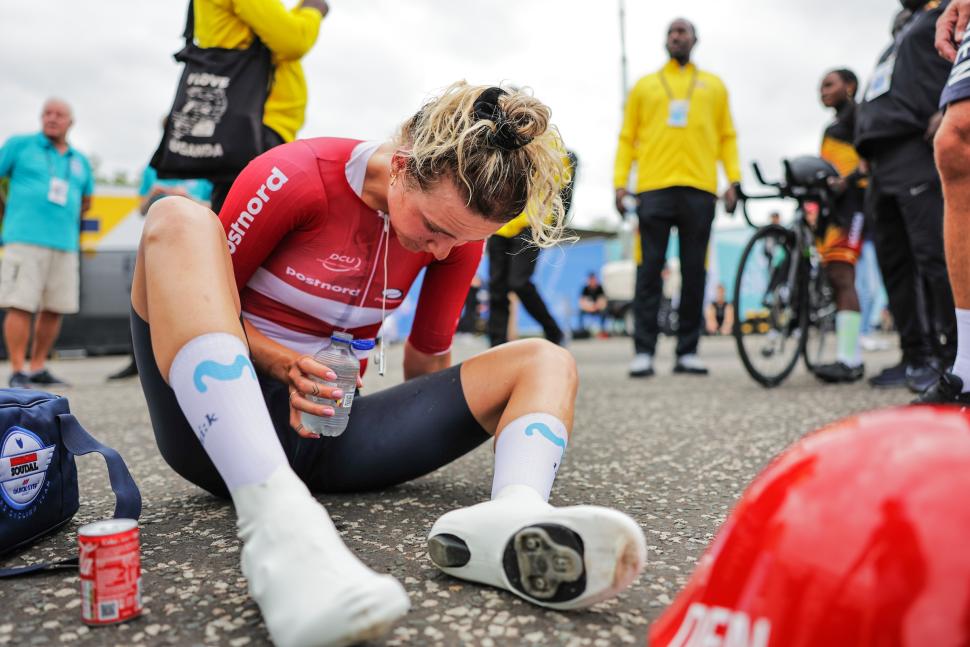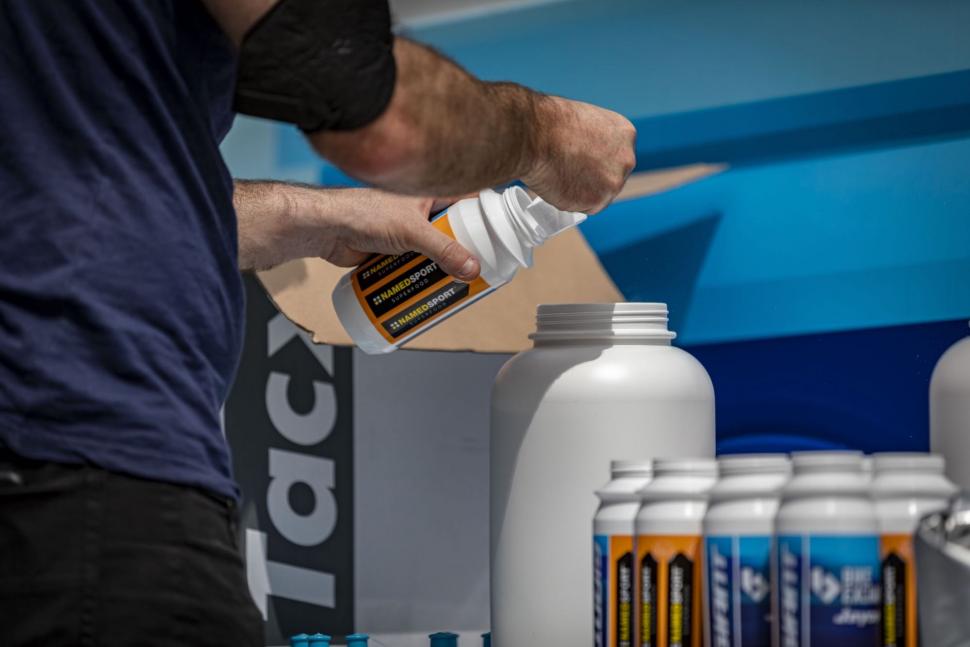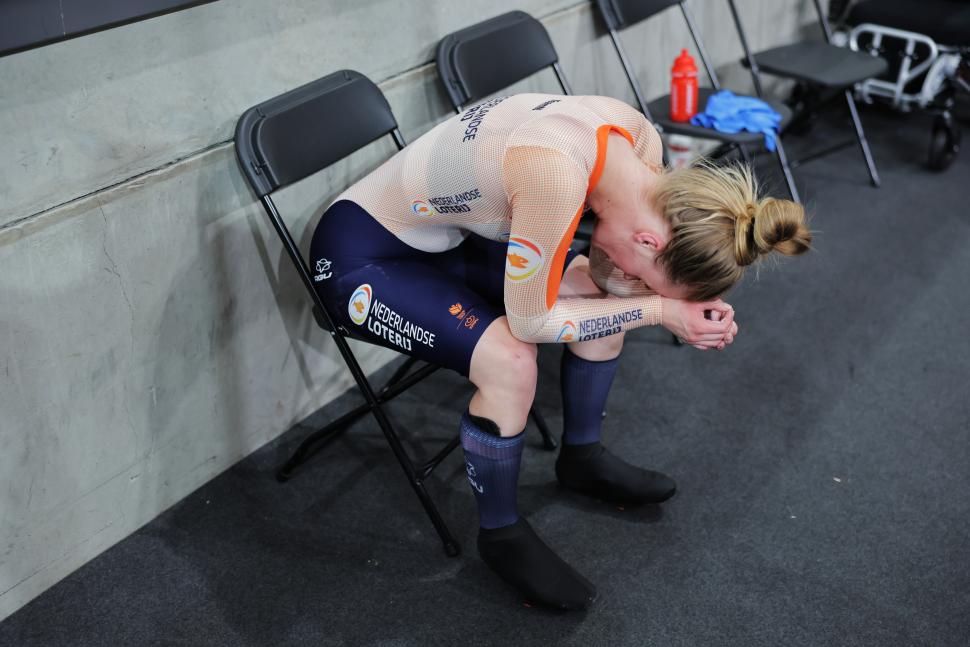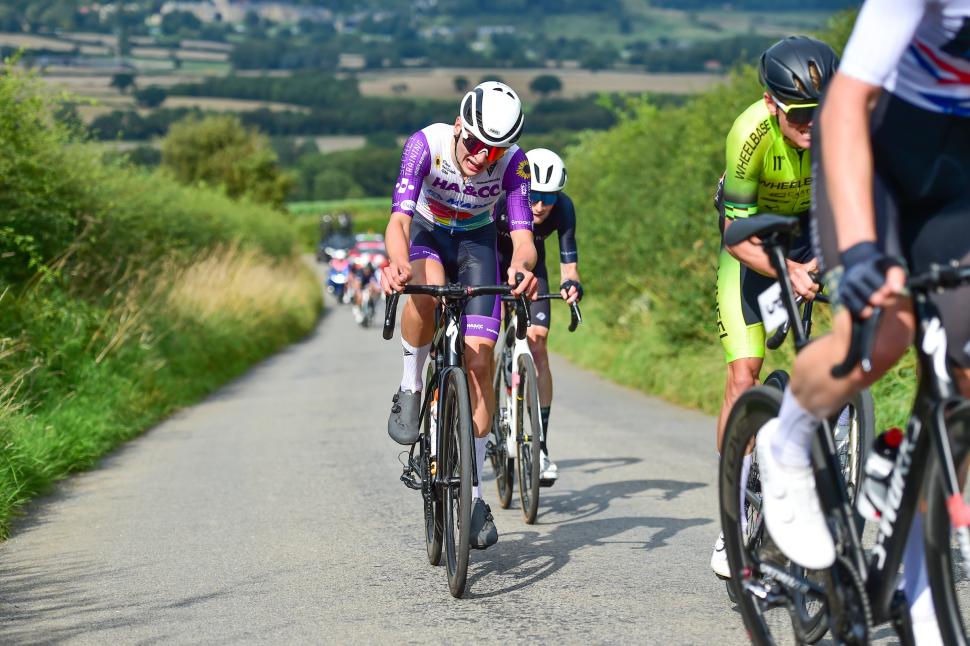- News
- Reviews
- Bikes
- Accessories
- Accessories - misc
- Computer mounts
- Bags
- Bar ends
- Bike bags & cases
- Bottle cages
- Bottles
- Cameras
- Car racks
- Child seats
- Computers
- Glasses
- GPS units
- Helmets
- Lights - front
- Lights - rear
- Lights - sets
- Locks
- Mirrors
- Mudguards
- Racks
- Pumps & CO2 inflators
- Puncture kits
- Reflectives
- Smart watches
- Stands and racks
- Trailers
- Clothing
- Components
- Bar tape & grips
- Bottom brackets
- Brake & gear cables
- Brake & STI levers
- Brake pads & spares
- Brakes
- Cassettes & freewheels
- Chains
- Chainsets & chainrings
- Derailleurs - front
- Derailleurs - rear
- Forks
- Gear levers & shifters
- Groupsets
- Handlebars & extensions
- Headsets
- Hubs
- Inner tubes
- Pedals
- Quick releases & skewers
- Saddles
- Seatposts
- Stems
- Wheels
- Tyres
- Health, fitness and nutrition
- Tools and workshop
- Miscellaneous
- Buyers Guides
- Features
- Forum
- Recommends
- Podcast
 Why do hard sprint efforts on the bike make you want to vomit Dec 2023
Why do hard sprint efforts on the bike make you want to vomit Dec 2023Why do hard sprint efforts on the bike make you want to vomit?
Dutch cyclist Jeffrey Hoogland recently shattered the 1km track world record, followed by an episode of vomiting into a bin - a somewhat unpleasant but not uncommon occurrence. Many road.cc readers have likely experienced similar reactions after pushing their limits. But what prompts this phenomenon? What's going on down below that makes its feelings so visibly known up top? We’re sick of not knowing, so we thought we’d dig deep into the phenomenon known as “exercise-induced vomiting”…
In 2013, Francis Pervis set a new 1km world record of 56.303 seconds. It would turn out to be the longest-standing record in track cycling. That was until 1st November 2023 when current world champion and Dutch powerhouse Jeffrey Hoogland dropped that mark to 55.443 seconds.
Along the way, the 30-year-old reportedly generated up to 3,000 watts and 500 Nm torque, his V8 engine complemented by the thinner air of Aguascalientes, Mexico, which nestles at around 2,000m above sea level. It was an immense effort and one that Hoogland celebrated by, according to Dutch daily AD, “panting like a leopard”.
The minute’s effort left him mute for quite some time. He was handed an oxygen mask to revive him. It had little effect; instead, he sought revival by remounting his bike and rolling around the velodrome. The blood began to flow once more, pushing out the toxins… and resulting in Hoogland throwing up in a bin.
> 10 Tour de France top tips to sprint like a pro
According to a crackingly prosaic paper by Dr Patrick Wilson, assistant professor of exercise at Old Dominion University in Virginia, US, entitled, “‘I think I’m gonna hurl’: a narrative review of the causes of nausea and vomiting in sport”, nausea has many potential triggers that cover nutritional, pharmacological, environmental and psychological domains. “In all cases, the perception of nausea is believed to arise from activation of the ‘vomiting centre’ in the medulla oblongata within the brain stem,” the paper reads.
“The vomiting centre can be activated directly or indirectly through pathways that interact with the GI [gastro intestinal] tract, chemoreceptor trigger zone, cerebral cortex and thalamus, and vestibular system. If activation of the vomiting centre via these pathways is sufficiently strong, efferent motor pathways that innervate the upper GI tract, lower GI tract, diaphragm and abdominal muscles will cause retching or vomiting.”
> How hard is it to train like a pro cyclist?
So something within Hoogland’s muscle-laden system stimulated his vomiting centre to such an extent that he defiled said bin. But what exactly? Well, one of the key reasons could have been his reported pre-race booster, namely a sodium bicarbonate mix. Sodium bicarb, or baking powder, is a buffer, meaning it’s alkaline and buffers acidic environments. Which is exactly why the likes of Hoogland use it for high-intensity exercise.
You see, as you work harder, you generate increasing amounts of lactic acid – a by-product of metabolising carbohydrates. This is recycled within the cell until it reaches saturation point, from where it floods into your bloodstream. This lowers the blood’s pH and, whether through physical or psychological reasons (the jury’s out), your power output drops. Since bicarbonate is an alkaline, it raises the pH of your blood before exercise, effectively meaning you have a greater bandwidth to delve into before pH reaches wattage-dropping levels.
Studies show that the optimal dose is around 0.3g per kilogramme bodyweight, albeit this varies by individual. But if we take that figure and apply it to the 97kg powerhouse Hoogland, we’re looking at 29.1g sodium bicarbonate. This can be consumed in powdered or pill form and is recommended to consume anywhere from 75 minutes to three hours before hard efforts. This is all very well, but this alkaline mixture has side effects for many, which include bloating, abdominal pain, nausea and vomiting.
> How to get the most from your limited training time
Was sodium bicarbonate responsible? Possibly. Or was it the actually the lactate it was being used to buffer against? A study in the journal ‘Physiological Reports’ examined whether there was a relationship between nausea level and lactic acidosis (a type of metabolic acidosis that occurs when lactic acid builds up in your blood) during recovery from sprinting, which is as if it could have been written by Hoogland himself.
This, said the researchers back in 2019, was a first as “the aetiology of nausea associated with exercise has only been investigated in relation to endurance exercise… there is evidence that the redirection of bloodflow from the gut to exercising muscle may result in gut ischemia and mucosal damage, thereby increasing intestinal permeability. These gastrointestinal perturbations, in turn, are associated with elevated plasma endotoxin levels and concomitant nausea”. Or, in less technical terms, as toxins rise during endurance exercise, so does whatever’s in your stomach.
At least you're not a runner…
To that end, they referenced a study that out of 145 endurance runners, up to 84% had experienced gastrointestinal symptoms during at least one training run over a period of 30 days, albeit what constituted a symptom was pretty broad and included belching and flatulence. That figure dropped markedly for more severe issues like nausea, though still nestled at 13.8% and 21.7% for men and women, respectively.
So, while endurance exercise is swimming in vomiting studies, there is much less out there on sprinting; which is why they had 13 recreationally active males complete a 60-second bout of maximal-intensity cycling. Prior to, and for 45 minutes following exercise, blood pH and lactate levels were measured together with nausea ratings.
What did they find? That there was a strong positive relationship between nausea and both lactate concentrations and hydrogen-ion concentrations, that rise with lactate. So, could lactate have caused Hoogland - and many of you folks who are partial to the odd sprint - high-intensity nausea?
“That could be it but it’s hard to parse out cause and effect, as there are many hormonal and molecular changes that happen with intense exercise. That means it might not be the lactate per se, but things that also rise in conjunction with lactate.”
That’s from Dr Wilson, who we mentioned above. After reading his puking paper, we felt compelled to tap up the American for his athletic-gut insight (which is immense. Hence, he’s written a book called ‘The Athlete’s Gut’).
“For me, it’s probably multifactorial, but the secretion of hormones like adrenaline and noradrenaline plays a role,” Wilson continues. “The amount of these hormones released during exercise is directly related to exercise intensity. In addition, fasting and caffeine also increase the release of these hormones, and are known to exacerbate nausea with intense exercise.”
Notably, concentrations of epinephrine and norepinephrine in the blood rise with exercise intensity. Further evidence supporting the catecholamine idea comes not from a sporting but a medical setting. Nine patients diagnosed with pheochromocytomas and paragangliomas, which are tumours that affect the adrenal glands and can cause excess secretion of catecholamines (a group of neurotransmitters and hormones that play a crucial role in the sympathetic nervous system's "fight or flight" response), reported nausea and vomiting, especially when exercising. Removal of the primary tumours in the aforementioned nine patients led to an end to the vomiting.
> Can you get fit by cramming all of your riding into the weekend?
“To lessen the chances of nausea in the first place, you should obviously avoid eating anything substantial (more than a couple hundred calories) within a couple hours of doing hard exercise,” says Wilson. “Nutrients like fat, solid protein sources and fibre can delay stomach emptying. The question around light exercise is more variable. I would avoid eating a large meal within an hour of exercise, but other than that it comes down to the person and whether they have a history of nausea with exercise.”
Location! Location! Location!
Hoogland and his team would have sorted nutrition to forensic detail. So, we’d proffer that’s not the reason. But there is one more contender according to Wilson’s paper: Aguascalientes itself: “A final environment factor that plays a role in a smaller subset of nausea cases is altitude exposure,” read the paper. “The mechanisms responsible for nausea in altitude sickness may include activation of the sympathetic nervous system, cerebral oedema, cerebral bloodflow changes and headache-induced nausea.”
So, there you have it. Exercise-induced vomiting from intense exercise is potentially down to sodium bicarbonate, lactic acid, fasting, caffeine, hormonal rushes, poor food timing and altitude.
If you experience vomiting after intense sprints and have been using sodium bicarbonate, you might want to consider stopping the soda and observing any changes. Alternatively, if it's related to lactate, experimenting with sodium bicarbonate might be worth a try. You could also consider the timing of your meals as eating too close to exercising or on an empty stomach may contribute to nausea.
Or, take comfort from the fact that you’re not a runner. Cue send-off from Wilson’s paper: “Running seems to stimulate nausea and vomiting more than cycling, which could be down to the ‘vertical displacement to the abdomen that’s induced by running’.”
James is an experienced cycling writer whose palmares includes penning three books. His latest, Riding with the Rocketmen, charted his painful journey to the Etape du Tour finish line. Along the way, he learnt from Ineos in Andorra, got aero with Lawson Craddock in a wind-tunnel and cyclocrossed with Nick Craig. Despite that, he remained steadfastly moderate! He also edits the official Tour de France Guide, plus pens words for many other outlets, both in print and digital.
Latest Comments
- HoarseMann 3 min 43 sec ago
Couple are forced to sell new Land Rover at a £14,000 loss ONE MONTH after buying it after insurers cancelled their policy - and manufacturer won't...
- chrisonabike 8 min 23 sec ago
I once went to a cafe in Dundee for fruitcake but they were out of their eponymous product. Worse - on the way back we tried Abernethy but they...
- chrisonabike 13 min ago
It's also perfectly possible to drive a bus or a truck carefully, but for some reason most people are not keen to cycle around them. And indeed...
- OldRidgeback 48 min 16 sec ago
Interesting, tho they only take narrow 20" slick tyres. I'd want to be able to use 1.75 Maxxis DTHs.
- don simon fbpe 1 hour 16 min ago
Who'd've thought that a certain whinging section (right whingers get uppity for calling them what they are) of society would resort to division,...
- Exup 2 hours 48 min ago
At least some justice is being done........
- BIRMINGHAMisaDUMP 2 hours 58 min ago
I imagine the Police treat bike theft as an insurance issue rather than a criminal issue. Can't blame them to be honest. The best thing is to use...
- David9694 3 hours 25 min ago
Police launch investigation into destruction of barber shop in Hythe High Street...
- Nick T 12 hours 48 min ago
They need to use some harder material for the cleat retention clip really, that's worn out long before any bearing has had a chance to fail on...
- yiipeeia 15 hours 38 min ago
I am 67 and I cycle with two groups during the year The Haddenham Easyriders International who ride during the summer on Thursday evenings, and The...







Add new comment
1 comments
Fascinating, thanks. It was interesting in TCL this year how Matt Richardson was throwing up after every sprint whereas Lavreysen looked fresh as a daisy. I think the only time Matt didn't was after his solitary victory so perhaps in his case there's a big role in brain chemistry. I guess they keep these things very quiet but would be fascinating to get insight into their pre-ride nutrition.